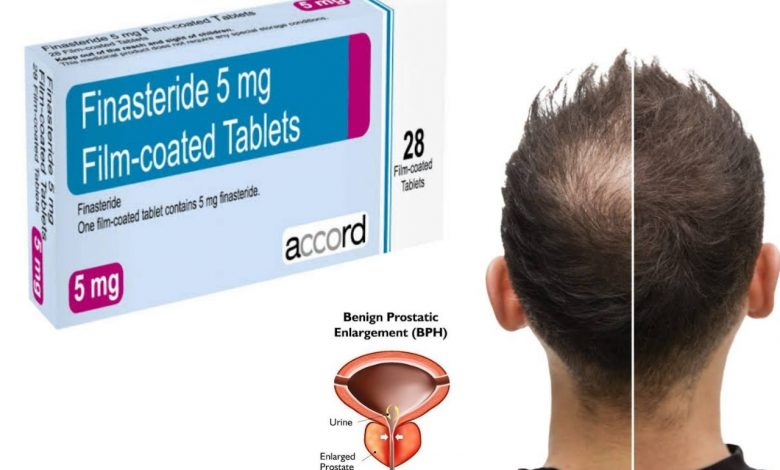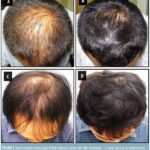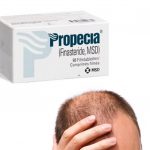Why Is Finasteride Not Working For You?

What is male pattern hair loss?
Male pattern hair loss is one of the most common types of diffuse thinning of the hair and balding that occurs in adult males.
• It is due to a combination of hormones (androgens) and a genetic predisposition.
• Male pattern hair loss is also called androgenetic alopecia.
• It is characterized by a receding hairline and hair loss on the top and front of the head.
• A similar type of hair loss in women, female pattern hair loss, results in thinning hair on the mid-frontal area of the scalp and is generally less severe than occurs in males.
What is Benign prostatic hyperplasia (BPH)?
Benign prostatic hyperplasia (BPH) also called prostate gland enlargement is a common condition as men get older. An enlarged prostate gland can cause uncomfortable urinary symptoms, such as blocking the flow of urine out of the bladder. It can also cause bladder, urinary tract, or kidney problems.
The severity of BPH symptoms in people who have prostate gland enlargement varies, but symptoms tend to gradually worsen over time. Common signs and symptoms of BPH include:
• Frequent or urgent need to urinate
• Increased frequency of urination at night (nocturia)
• Difficulty starting urination
• Weak urine stream or a stream that stops and starts
• Dribbling at the end of urination
• Inability to completely empty the bladder
Less common signs and symptoms include:
• Urinary tract infection
• Inability to urinate
• Blood in the urine
The size of your prostate doesn’t necessarily determine the severity of your symptoms. Some men with only slightly enlarged prostates can have significant symptoms, while other men with very enlarged prostates can have only minor urinary symptoms. In some men, symptoms eventually stabilize and might even improve over time.
There are several effective treatments for prostate gland enlargement, including medications, minimally invasive therapies, and surgery. To choose the best option, you and your doctor will consider your symptoms, the size of your prostate, other health conditions you might have, and your preferences.
What is Finasteride?
Finasteride, also known by the brand name Proscar is a medication used alone or in combination with another medication (doxazosin [Cardura]) to treat BPH. Finasteride is used to treat symptoms of BPH such as retention (sudden inability to urinate).
It also may decrease the chance that prostate surgery will be needed. Another brand of finasteride known as Propecia is used to treat male pattern hair loss (gradual thinning of the hair on the scalp, leading to a receding hairline or balding on the top of the head in men.) Finasteride (Propecia) has not been shown to treat thinning hair at the temples and is not used to treat hair loss in women or children.
How Finasteride work
Finasteride is in a class of medications called 5-alpha reductase inhibitors. Finasteride treats BPH by blocking the body’s production of a male hormone that causes the prostate to enlarge. Finasteride treats male pattern hair loss by blocking the body’s production of a male hormone in the scalp that stops hair growth.
How to take finasteride
All possible dosages and forms may not be included here. Your dose, form, and how often you take it will depend on:
• your age
• the condition being treated
• how severe your condition is
• other medical conditions you have
• how you react to the first dose
Dosage for male pattern hair loss
Generic: Finasteride
• Form: oral tablet
• Strengths: 1 mg
Brand: Propecia
• Form: oral tablet
• Strengths: 1 mg
Adult dosage (ages 18 years and older)
• Typical dosage: 1 mg per day.
Child dosage (ages 0-17 years)
Dosage for people younger than 18 years has not been established. This drug is not prescribed for use in children.
Dosage for benign prostatic hyperplasia
Generic: Finasteride
• Form: oral tablet
• Strengths: 5 mg
Brand: Proscar
• Form: oral tablet
• Strengths: 5 mg
Adult dosage (ages 18 years and older)
• Typical dosage: 5 mg per day.
Child dosage (ages 0–17 years)
Dosage for people younger than 18 years has not been established. This drug is not prescribed for use in children.
What are the signs that Finasteride is not working?
Depending on the reason why you are taking Finasteride, the following are signs that indicate that finasteride is not working for you:
Finasteride For BPH
Finasteride may not be working for BPH if
- Test results indicate that testosterone is not being stopped from turning into dihydrotestosterone (DHT)
- The prostate does not shrink but continues to grow bigger
- You continue to experience difficulty starting urination and increased frequency of urination at night.
- Weak urine stream or a stream that stops and starts in addition to dribbling at the end of urination
- Seminal analysis indicates improved sperm counts despite starting finasteride
Finasteride For Hairloss
Finasteride may not be working for hair loss if:
- Test results indicate that the drug is not blocking the body’s production of a male hormone in the scalp that stops hair growth.
- Hairline continues to recede as well as other areas of the scalp affected by male pattern baldness.
If you haven’t noticed any improvements in BPH symptoms or your hair after taking finasteride for the prescribed duration, it’s best to talk to your healthcare provider. If finasteride isn’t effective for you after this amount of time, further treatment may not have a significant effect on your BPH or hair loss.
Can finasteride not work for some people?
Yes, people respond differently to finasteride, the fact that the medication works for most people, it may not necessarily work for everyone. Some people either don’t have many receptors in their body for the drug to bind to and produce its effects, or the receptors that they do have don’t work well. This could be due to genetic mutations or underlying diseases. An average dose of a drug would only produce a limited response in these patients.
Finasteride is unlikely to work in people that are completely bald or have very little hair left, or those suffering from hair loss that is not attributed to male pattern baldness (such as alopecia). Men who start taking daily finasteride at the first signs of hair loss will not go bald.
Why is finasteride not working anymore?
In some people, finasteride can suddenly stop working after some time. This abrupt loss of effectiveness is more likely to be caused by the growing problem of fake finasteride in circulation.
In addition, you may have developed other medical conditions that are affecting the way finasteride works in your body. Hormonal issues, poor metabolism, poor sleep, high blood pressure, or stomach conditions could change the effect of your medications.
What are the side effects of finasteride?
Side effects requiring immediate medical attention
Along with its needed effects, finasteride may cause some unwanted effects. Although not all of these side effects may occur, if they do occur they may need medical attention.
Check with your doctor immediately if any of the following side effects occur while taking finasteride:
More common
• Chills
• cold sweats
• confusion
• dizziness, faintness, or lightheadedness when getting up suddenly from a lying or sitting position
Less common
• Bloating or swelling of the face, arms, hands, lower legs, or feet
• breast enlargement and tenderness
• hives or welts, itching, skin rash
• rapid weight gain
• redness of the skin
• swelling of the lips and face
• tingling of the hands or feet
• unusual weight gain or loss
Incidence not known
• Clear or bloody discharge from the nipple
• dimpling of the breast skin
• inverted nipple
• lump in the breast or under the arm
• persistent crusting or scaling of the nipple
• redness or swelling of the breast
• sore on the skin of the breast that does not heal
Side effects not requiring immediate medical attention
Some side effects of finasteride may occur that usually do not need medical attention. These side effects may go away during treatment as your body adjusts to the medicine. Also, your health care professional may be able to tell you about ways to prevent or reduce some of these side effects.
Check with your health care professional if any of the following side effects continue or are bothersome or if you have any questions about them:
More common
• Decreased interest in sexual intercourse
• inability to have or keep an erection
• loss in sexual ability, desire, drive, or performance
Less common
• Runny or stuffy nose
• sleepiness or unusual drowsiness
• sneezing
Less common or rare
• Back pain
• decreased amount of semen
• diarrhea
• dizziness
• headache
• stomach pain
Incidence not known
• Testicular pain
Taking finasteride may increase the risk that you will develop high-grade prostate cancer (a type of prostate cancer that spreads and grows more quickly than other types of prostate cancer) or breast cancer. Talk to your doctor about the risks of taking finasteride.
If you experience a serious side effect, you or your doctor may send a report to the Food and Drug Administration’s (FDA) MedWatch Adverse Event Reporting program online by phone (1-800-332-1088).
Finasteride Alternatives
The U.S. Food and Drug Administration (FDA) has approved the following finasteride alternatives to treat male-pattern hair loss. Here’s the lowdown on each.
Topical minoxidil (available without a prescription)
Widely available at stores and online, this is the most commonly used treatment for male-pattern hair loss.
• What studies show: In clinical trials, minoxidil has been shown to reduce hair loss, stimulate hair growth, and strengthen existing strands of hair. While minoxidil can help, you’re unlikely to see full regrowth.
• How to use: Apply to your scalp.
• When to use: Minoxidil is applied twice a day, every day.
• How long it takes to see results: Some men respond to minoxidil better than others, and some men fail to see any difference. If minoxidil works for you, it can take up to six months to see results. It’s important to follow directions and apply minoxidil twice a day every day.
• Possible side effects: When using minoxidil, some men develop an irritated scalp. The newer formulation, which is a foam, seems to reduce this risk. Other possible side effects include an itchy scalp or headaches.
• Can be used alone: Many men see results when they use only minoxidil. If you see a dermatologist, your dermatologist may add a prescription medication to your treatment plan. This can improve results.
• If you stop using minoxidil: The new hair that grew will fall out. This usually happens within three to four months. Dermatologists report that some men say their hair loss looks worse than before they started applying minoxidil. What’s happening is that you’re seeing the hair loss that would have occurred had you never treated it.
About laser devices for male-pattern hair loss
Several laser devices are now available to treat hair loss at home. The FDA has cleared some. If you see “FDA cleared” on the packaging or within information about the laser, this means the FDA recognizes the laser as a safe treatment.
The requirements for getting FDA cleared are much less stringent than for getting FDA approved.





